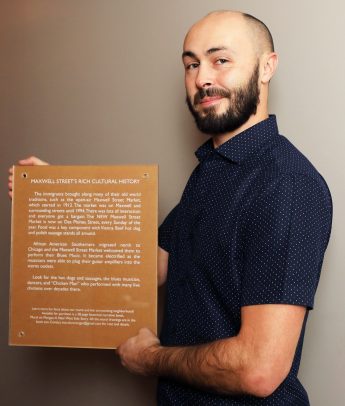Mural, activity book highlight history of Near West Side

Nick Goettling, the artist who completed the Mural on Morgan, holds one of four silk-screened informative plaques created for the mural. historical context and what it means to the Near West Side.
Vienna Beef hot dogs, the Cubs and UIC.
Besides being famously tied to Chicago, the three city giants have something else in common: they all started on the Near West Side, an area that covers the UIC campus, University Village, Little Italy and other neighborhoods.
And they’re all featured in an 82-by-12-foot mural on Morgan Street, which was painted in 2013, and can be found just south of 15th Street, before the viaduct on the west side.
But now a new activity book called Mural on Morgan: A Near West Side Story reaches as far back as the late 1800s to tell the area’s stories. The book guides readers through topics covered in the mural, including the railroad industry, Maxwell Street, South Water Market, the beginnings of the UIC campus and more.
“The mural itself is really the history of the neighborhood,” said Nancy Plax, director of community outreach for Connecting4Communities. Plax and seven other residents of the Near West Side — the Mural on Morgan Committee — led a public call for art that made the mural possible. Artist Nick Goettling won the contract for the project, sketching and painting highlights on the viaduct. When the mural was done, Plax was inspired to add to the momentum.
“I felt there was an incredible amount of history for everybody to know,” said Plax.
After pitching the idea, she and committee members self-published an accompanying historical narrative, a book that encourages reader engagement, interaction and learning for people of all ages.
“The mural was more to give a feel and curiosity,” added Goettling. “The book goes into much greater detail, into the specifics of the imagery, history, groups, figures and what all that means,” he said. Some representations capture waves of immigration, the birth of electric blues and aerial maps of railways.
“[The mural] breaks it down for people,” said Elsa Soto, a committee member and assistant director of the Academic Resource Center in the College of Engineering. The activity book features hot-dog maze, which Soto created, a word search and black-and-white outlines of the mural that readers can color in. There’s even an image search that people can use for a self-guided neighborhood walk. The book will also serve as a companion piece to four silk-screened, plexiglass signs that will soon be placed on the mural to explain what the artwork means and its historical context.
The approach encourages a different kind of learning, Goettling noted.
“Local history and where you come from, where your neighborhood comes from, can be very dry if you’re just reading it,” he said. “But when you’re really engaging with it — like you can with this book — using imagery and activities to engage with the history, that can be really valuable, and it can inspire people to be active in their community because they’ll know more about it.”
Plax hopes that the book’s impact will be far reaching. She’s already secured a spot for it at the Jane Addams Hull-House Museum’s gift shop, where it sells for $10, crayons and tax included. Local deliveries, priced at $13.95, are also available. To order a copy, email muralonmorgan@gmail.com.
The books make a great holiday present, Plax said.
“It’s a great gift for people who were born here or grew up in the neighborhood, even students,” she said.
Profits will help maintain the existing mural on Morgan and fund more murals near city viaducts. In the future, Plax hopes to launch a website where she can share before and after photos, facts and other historical information.
“It’s important,” she said. “This is history, and we just want to grow it.”
For more information, visit the official Mural on Morgan Facebook page.
